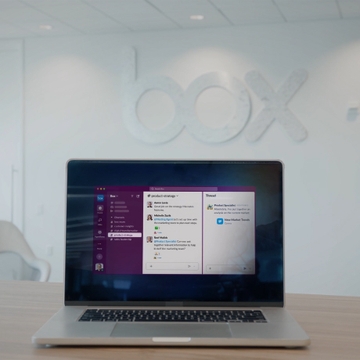SEEK is in the business of matchmaking. But these relationships, while often long-lasting and hopefully happiness-inducing, are not what people outside Australia might expect. As the country’s top employment marketplace, the Melbourne-based company is all about facilitating just the right fit between hirers and job seekers.
Founded in 1997, SEEK cornered its home market and then sought to bring its job-matching expertise to new areas. A series of strategic acquisitions across Asia Pacific and the Americas expanded the company’s footprint to include employment, education, commercial and volunteer businesses in 18 countries.
This rapid growth led to new challenges – chief among them, leveraging resources and instilling a team culture across a diverse portfolio of businesses. To create meaningful connections among its workforce, the company needed an agile collaboration tool. Slack rapidly emerged as the solution for simplifying communication and building community among SEEK’s multinational workforce.
Channels streamline collaboration and communication
Originally adopted by the DevOps team at SEEK’s corporate headquarters, Slack gradually replaced Skype for Business as the communication method of choice across the company’s Australian operations, according to Mark Sweeney, SEEK’s workspace technology manager. ‘The next thing we knew, half the company was using it,’ he says. ‘There were clear benefits for us in moving to Slack.’
Slack channels – digital spaces where teams can share ideas, make decisions and move work forward – were a big selling point among team members. Channels proved especially critical for knowledge sharing as SEEK brought new acquisitions into the fold. ‘We have multiple brands across Asia Pacific, Australia and South America,’ Sweeney says. ‘They were all building their own mobile apps and search platforms. Our intent is, “Let’s build this once and then ship it globally, rather than having these disparate teams all working separately.”’
Fortunately, SEEK and its acquisitions already spoke a common language: Slack. ‘A lot of those organisations were already using Slack, mainly in their product development and strategy teams,’ Sweeney says. ‘It was time to start having those teams come together to work on shared products and collaborate across borders. Channels, along with Zoom, which integrates nicely, have been key in that success, for both ad hoc conversations and planning projects. Channels have played a massive role in helping to bring those teams together.’
Teams from across the company rely on channels to resolve issues around the clock. ‘The channels light up when something goes wrong,’ Sweeney says. ‘People are quickly advocating, having a conversation, and stakeholders are easily able to see how things are going.’
With the Zoom integration, SEEK’s default calling and video conference app, team members can quickly get on a call for further clarification without ever leaving Slack. ‘Someone can reach out with an issue, and then we can jump straight into Zoom and help them remotely,’ Sweeney says. ‘It’s a tight integration.’
Channels have proved equally valuable in building a team culture across acquisitions. ‘Team culture comes into Slack quite heavily,’ Sweeney says. ‘That’s where [teams] collaborate and communicate, whether they’re talking about DevOps or what they had for lunch or sharing photos of their cats. Slack is not just about work. It’s about getting to know people.’
Email traffic dropped significantly as SEEK migrated to Slack to strengthen its connections and culture globally. SEEK’s primary Slack workspace now has more than 1,000 weekly active users, who collectively send more than 25,000 messages on a daily basis. This constant flow of information allows the company to collaborate more closely and leverage its in-house expertise more fully.
‘It was time to start having those teams come together to work on shared products and collaborate across borders... Channels have played a massive role in helping to bring those teams together,’


Finbot speeds up service for the Finance Operations team
Day after day, the Finance Operations team was bogged down with repeat questions from colleagues across sales and customer service teams. ‘We would be sitting with 250 to 300 unanswered queries a day,’ says Mathieu Longin, SEEK’s Finance Operations manager. Given the backlog, the inquirers could expect to wait hours (or sometimes days) for a response. ‘We were getting the same questions all the time from stakeholders: “Can I get an account statement? Can I get a spend report? Can I have a copy of an invoice?” It’s those sorts of questions that you don’t really want to answer because it takes you away from your own work. You’d wonder, “Why isn’t this just automated?”’
Emily Purcell, SEEK’s corporate and government credit controller, and Bradley Bramham, the inside support credit team leader, kicked off a four-year search for a solution. They’d looked at robotic process automation, but it seemed too complex for so many stakeholders to use. ‘Once Slack was rolled out company-wide two years ago and we started understanding what Slack could do,’ Longin says, ‘it became obvious this was a tool that we wanted to start using to be more efficient.’
That lightbulb moment prompted a consultation with a DevOps team that agreed to take on the challenge during a three-day hackathon. Their solution, dubbed Finbot, won the People’s Choice Award at the hackathon.
Finbot fields routine queries in Slack. Stakeholders can type a simple command in Slack to pull up an account’s details. They can check the account balance or send a statement by email – all from within Slack. Finbot also includes an FAQ linked to Jive, an intranet software solution, where SEEK employees can find answers to questions on their own. In seconds, they can achieve what previously required several hours or days. ‘Slack has opened the door for us to service queries 24/7,’ Longin says. ‘The friction is gone. We’ve given people a tool they can use to help them better manage their portfolios and better service their clients.’
Thanks to Finbot, the Finance Operations team has seen a significant drop in queries, freeing up their time to focus on other value-adding initiatives – including what functions they should next add to Finbot.
‘Slack has opened the door for us to service queries 24/7. The friction is gone.’
Slack makes it easy to conduct computer health checks
SEEK’s global expansion required the company to not only integrate offices but also technology. That job fell to Tania Dastres, a senior Apple system administrator at SEEK. Dastres’s top priority is to ensure that Mac computers across the company are running smoothly and are up to date on all security protocols.
When SEEK expanded to Asia, Dastres faced a two-pronged challenge: getting both new employees and machines up to speed quickly. ‘Having to deal with brand-new teams with different skill levels, and Macs in all sorts of different states,’ she says, ‘meant that I needed to find a different way to be able to find out information about a particular machine at any time – and let the level 1 and level 2 techs over there find out information about a particular machine in an easy way. Slack was a good medium to do that.’
Dastres developed a Slackbot for the enterprise IT management software Jamf that enables support techs to easily run a ‘health check’ on any machine via a slash command in Slack. The command pulls relevant data from Jamf Pro into Slack. ‘The fact that an action that would require a lot of time and experience to be able to accomplish via the Jamf Pro console would be possible via just a couple of clicks on Slack is really cool,’ she says.
Using the Jamf bot, techs can find a specific computer by entering a search string such as a serial number, asset tag, username, IP address or Mac address – or even ‘wild card’ asterisks to fill in blanks. ‘From those results,’ Dastres says, ‘there’s a “more information” button you can click on that gives you a full summary of what state a machine is in.’ The bot flags action items with emojis so that techs know what to focus on. ‘With the warning emoji, immediately you’re aware that there’s something wrong with this Mac that you need to investigate.’ The bot has not only enabled techs to provide speedier resolutions but also proactive support as SEEK expands.
SEEK is all about connecting job seekers and hirers around the globe. With Slack, the company has been able to automate routine tasks, share knowledge and enable international collaboration. Those efficiencies leave more time for the big things – like helping 215 million people (and counting) make their next career move.
















